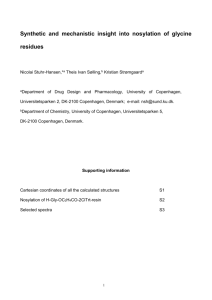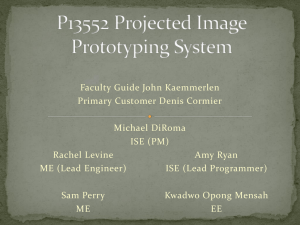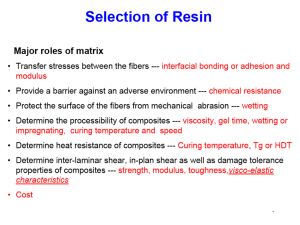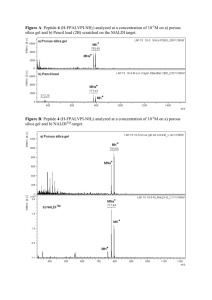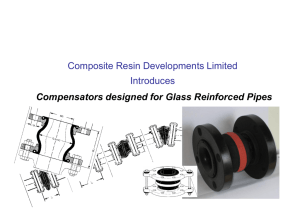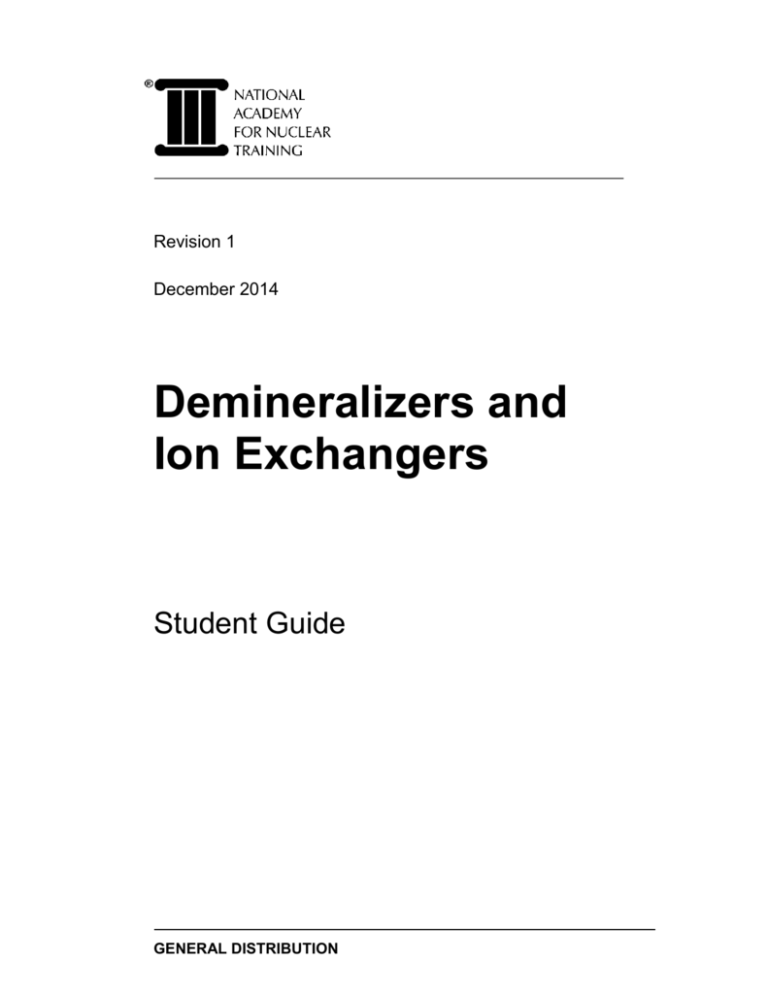
Revision 1
December 2014
Demineralizers and
Ion Exchangers
Student Guide
GENERAL DISTRIBUTION
GENERAL DISTRIBUTION: Copyright © 2014 by the National Academy for Nuclear Training. Not for sale or
for commercial use. This document may be used or reproduced by Academy members and participants. Not for
public distribution, delivery to, or reproduction by any third party without the prior agreement of the Academy.
All other rights reserved.
NOTICE: This information was prepared in connection with work sponsored by the Institute of Nuclear Power
Operations (INPO). Neither INPO, INPO members, INPO participants, nor any person acting on behalf of them
(a) makes any warranty or representation, expressed or implied, with respect to the accuracy, completeness, or
usefulness of the information contained in this document, or that the use of any information, apparatus, method,
or process disclosed in this document may not infringe on privately owned rights, or (b) assumes any liabilities
with respect to the use of, or for damages resulting from the use of any information, apparatus, method, or
process disclosed in this document.
ii
Table of Contents
INTRODUCTION ..................................................................................................................... 1
TLO 1 DEMINERALIZER OPERATION..................................................................................... 2
Overview .......................................................................................................................... 2
ELO 1.1 Demineralizers and Ion Exchangers Purpose .................................................... 3
ELO 1.2 Principles of Operation ..................................................................................... 4
ELO 1.3 Regeneration ..................................................................................................... 6
ELO 1.4 Changes in Demineralizer Operation .............................................................. 12
ELO 1.5 pH Effects on Demineralizer Use ................................................................... 15
ELO 1.6 Decontamination Factor .................................................................................. 17
ELO 1.7 Plant Evolutions that Affect Demineralizer Operation ................................... 20
ELO 1.8 Saturated Demineralizer .................................................................................. 22
DEMINERALIZERS AND ION EXCHANGERS SUMMARY ......................................................... 24
iii
This page is intentionally blank.
iv
Demineralizers and Ion Exchangers
Revision History
Revision
Date
Version
Number
0
Purpose for Revision
New Document
Performed
By
OGF Team
Introduction
This course will explore how demineralizers and ion exchangers maintain
water quality and water chemistry during nuclear power plant operations.
Water chemistry plays a vital role in nuclear power plant operations; it
helps maintain radiation levels at minimums, controls reactivity poisons,
and improves the durability of plant components through corrosion control.
Rev 1
1
Demineralizers and ion exchangers equipment controls water chemistry in a
plant. Proper water chemistry is important to safe plant operations because
it minimizes corrosion products that could become activated and cause high
radiation levels, and helps maintain level amounts of reactivity poisons in
solution in a pressurized water reactor (PWR).
Objectives
At the completion of this training session, the trainee will demonstrate
mastery of this topic by passing a written exam with a grade of 80 percent
or higher on the following Terminal Learning Objective (TLO):
1. Explain demineralizer operation and its effect on power plant
operation.
TLO 1 Demineralizer Operation
Overview
Demineralizers and ion exchangers themselves are not mechanically
complex; however, they do facilitate some complex chemical processes on a
molecular level to manage the water qualities of various plant systems.
Water quality and water chemistry are important because these factors
provide short-term and long-term benefits and functions within various
plant systems.
Objectives
Upon completion of this lesson, you will be able to do the following:
1. State the purpose of a demineralizer.
2. Describe the principles of demineralizer operation.
3. Describe the process of demineralizer regeneration.
4. Describe the following demineralizer conditions to include causes,
hazards, and corrective measures as applicable:
a. Excessive differential pressure
b. Channeling
c. Excessive temperature
d. Breakthrough
e. Leakage
5. Explain how demineralizer use affects pH.
6. Describe the decontamination factor and explain how it is calculated.
7. Describe plant evolutions that could affect demineralizer operation.
8. Explain the condition of a saturated demineralizer and the effect
temperature has upon it.
2
Rev 1
ELO 1.1 Demineralizers and Ion Exchangers Purpose
Introduction
Demineralizers in nuclear power plants remove ionic impurities, filter or
remove small particles, and help control pH of the water. Demineralizers
are important for controlling water quality and chemistry because they
provide short-term and long-term benefits and functions in the systems
where they are included.
Demineralizers and ion exchangers are passive components that have a
major effect on system performance by maintaining the system chemistry
stable and reducing the immediate effects of chemical excursions due to
such events as condenser tube leaks and other heat exchanger tube leaks
into clean systems. In the figure below, demineralizers provide filtration
and ion exchange for all water going to the steam generators.
Figure: Typical PWR
Purpose
Demineralizers (also called ion exchangers) hold ion exchange resins and
transport water through the resins to filter and ionize the water. Ion
exchangers are generally classified into two groups: single-bed ion
exchangers (containing either an anion or a cation resin) and mixed-bed ion
exchangers (containing both anion and cation resins). Key attributes of a
demineralizer are as follows:
Rev 1
3
A demineralizer is a cylindrical tank with connections at the top for
water inlet and resin addition, and connections at the bottom for the
water outlet and resin removal.
Inside the demineralizer, there are upper and lower retention elements
with a mesh size smaller than the resin beads that keep the resin beads
within the demineralizer.
Water that needs purification enters the top at a set flow rate and
flows down through the resin beads where the flow path causes a
physical filter effect as well as a chemical ion exchange, resulting in
purified water exiting the demineralizer.
Knowledge Check
Demineralizers are used in nuclear plants to… (select all
that apply)
A.
remove ionic impurities.
B.
remove small particles.
C.
control the pH of water.
D.
remove oil impurities.
ELO 1.2 Principles of Operation
Ion Exchange Definition
Ion exchange is an exchange of ions between two electrolytes or between an
electrolyte solution and a complex solution. In most cases, the term denotes
the processes of purification, separation, and decontamination of aqueous
and other ion-containing solutions with solid polymeric resins.
The process of ion exchange takes place within the demineralizer vessel.
This process removes ionic impurities and replaces them with acceptable
substitutes. Small resin beads serve as the vehicle to complete the ion
exchange within the demineralizer. The resin beads shown in the figure
below are porous and have many exchange sites for ion exchange to take
place. The resin generally contains exchangeable ions that are harmless
such as H+ or OH-.
Figure: Resin Beads
4
Rev 1
There are different types of resin beads available; the specific application
dictates the appropriate type of resin bead. Anion resins exchange ions with
undesirable negative ions and typically use the OH- or hydroxyl ion. Cation
resins exchange ions with undesirable positive ions and typically use the
H3O+ or hydronium ion.
Ion Exchange Reactions
The reactions that take place within the ion exchanger are reversible and
dependent on the resin selected. Numerous exchange reactions can take
place; below are a few examples:
𝐻 + + 𝑂𝐻 − ↔ 𝐻2 𝑂
𝐻2 𝑂
𝑁𝑎𝐶𝑙 ↔ 𝑁𝑎+ + 𝐶𝑙 −
𝑅 − 𝐻 + + 𝑅 + 𝑂𝐻 − + 𝑁𝑎+ + 𝐶𝑙 − → 𝑅 − 𝑁𝑎+ + 𝑅 + 𝐶𝑙− + 𝐻 + 𝑂𝐻 −
The R indicates the organic portion of the resin. The resins represented
above are a hydrogen cation resin R-H+ and a hydroxyl anion resin R+OH-.
The sodium chloride will separate from the water and form the Na+ and Clions. The hydrogen and hydroxyl ions from the resin react to form water.
The anion resin will exchange the negative Cl- for the negative OH- ion.
The cation resin will exchange the positive H+ for the positive Na+. These
exchanges take place because the resin has a higher affinity for the
undesirable ions than the mobile ions it contains. Ion affinity is selective
and the resin will give up one of its ions in favor of one for which it has a
higher affinity.
Many elements serve as ion exchangers. The table below lists some
common strong acid cation exchanger elements and compounds, as well as
some strong base anion exchanger elements, and compounds.
Selectivity of Ion Exchange Resins
Strong Acid Cation Exchanger
Strong Base Anion Exchanger
Barium
Iodide
Lead
Nitrate
Calcium
Bisulfite
Nickel
Chloride
Cadmium
Cyanide
Copper
Bicarbonate
Zinc
Hydroxide
Magnesium
Fluoride
Potassium
Sulfate
Ammonia
Rev 1
5
Strong Acid Cation Exchanger
Strong Base Anion Exchanger
Sodium
Hydrogen
Knowledge Check
A demineralizer contains resin with the following
properties:
𝑅 − 𝐻 + + 𝑅 + 𝑂𝐻−
What reactions would result if NaCl was in contact with
the resin beads?
A.
𝑅 − 𝑁𝑎+ + 𝑅 + 𝐶𝑙 − + 𝐻 + 𝑂𝐻 −
B.
𝑅 − 𝐶𝑙− + 𝑅 + 𝑁𝑎+ + 𝐻 + 𝑂𝐻 −
C.
𝑅 − 𝑅 + + 𝐻 + 𝐶𝑙− + 𝑁𝑎 + 𝑂𝐻 −
D.
𝑅 − 𝑂𝐻− + 𝑅 + 𝐻 + + 𝐶𝑙 + 𝑁𝑎−
Knowledge Check
Anion resins contain _____________ ions while cation
resins contain __________ ions.
A.
negative; positive
B.
positive; negative
C.
negative; hydroxyl
D.
hydronium; hydroxyl
ELO 1.3 Regeneration
Introduction
Sustained operation will eventually exhaust the resin bed, as the ion
exchanges deplete the exchangeable ions. Increased effluent conductivity is
a common indication of resin bed exhaustion. The resin exchange sites no
longer contain sufficient ions to exchange to be effective. Breakthrough
describes that point when the impurities in the outlet or effluent of the
demineralizer indicate resin exhaustion. A very small amount of impurities
or unwanted ions will pass through the demineralizer during normal
operation. Leakage refers to this small and often undetectable amount of
unwanted ions. Larger amounts of leakage indicate breakthrough and
6
Rev 1
require regeneration of the resin bed for the bed to function at peak
performance.
Figure: Single-Bed Demineralizer
Single-Bed Regeneration
Regeneration of the resins in single-bed demineralizers usually occurs in
place, without pumping the resins out to another location for regeneration.
The regeneration process is the same for cation beds and anion beds.
However, the regenerating solution is different. The table below lists the
regeneration stages and describes the process in each stage.
Stage
What Happens
Backwash
Water is pumped into the bottom of the ion exchanger
and up through the resin. This fluffs the resin and
washes out any entrained particles. The backwash
water goes out through the normal inlet distributor
piping at the top of the tank, but the valves are set to
direct the stream to a drain where the backwashed
particles flow to a container for waste disposal.
Regeneration
Opening the dilution water valve dilutes concentrated
acid or caustic to approximately 10 percent; a
distribution system immediately above the resin bed
introduces the dilute mix. The regenerating solution
flows through the resin and out the bottom of the tank
to the waste drain.
Rinsing
Rinsing removes any excess regenerating solution.
Rinse water is pumped into the top of the tank, flows
down through the resin bed, removes excess
regenerating solution, and flows out the bottom drain.
Rev 1
7
Stage
What Happens
Return to
Service
Once personnel close the drain valve and open the
outlet valve, the ion exchanger is ready for service.
Mixed-Bed Regeneration
A mixed-bed demineralizer is a demineralizer that includes both cation and
anion resin beads. In effect, it is equivalent to a number of single-bed
demineralizers in series. In a mixed-bed demineralizer, hydrogen and
hydroxyl ions replace more impurities and the effluent water is extremely
pure. The conductivity of this water can often be less than 0.06
microsiemens per centimeter (μS/cm or μmho/cm).
The design of mixed-bed demineralizers anticipates regeneration of the
resin in place, but the regeneration process is more complicated than the
regeneration of a single-bed ion exchanger. The table below lists the stages
for mixed-bed regeneration and describes the process in each stage.
Stage
What Happens
Backwash
Backwash water enters the vessel at the bottom and
exits through the top to a drain. The backwash water in
a mixed-bed unit must also separate the resins into
cation and anion beds in addition to washing out
entrained particles. The anion resin has a lower
specific gravity than the cation resin; therefore, as the
water flows through the bed, the lighter anion resin
beads float upward to the top. The mixed-bed becomes
a split bed. The separation line between the anion bed
at the top and the cation bed at the bottom is the resin
interface. Some resins need to be depleted to be
separated; other resins separate in either the depleted
form or the regenerated form.
Regeneration
A mixture of dilution water and caustic solution flows
into the top of the vessel, just above the anion bed. At
the same time, a mixture of dilution water and acid
enters the bottom of the vessel, below the cation bed.
The flow rate of the caustic solution down to the resin
interface is the same as the flow rate of the acid
solution up to the resin interface. Piping removes both
solutions at the interface and dumps them to a drain.
During the regeneration step, it is important to
maintain the cation and anion resins at their proper
volume. If not done, the resin interface will not occur
at the proper place in the vessel, exposing some resin
to the wrong regenerating solution.
8
Rev 1
Stage
What Happens
Slow Rinse
Flow of dilution water continues, with the caustic and
acid supplies cut off. This two-direction rinse flushes
out the last of the regenerating solutions from the two
beds and into the interface drain. Rinsing from two
directions at equal flow rates keeps the caustic solution
from flowing down into cation resin and depleting it.
Vent and Partial
Drain
The drain valve is opened, and some of the water is
drained out of the demineralizer so that there will be
space for the air that is needed to re-mix the resins. In
the air mix step, a blower usually supplies pressurized
air, which forces air in through the line entering the
bottom of the ion exchanger. The air mixes the resin
beads and then leaves through the vent in the top of the
vessel. When the resin is mixed, slowly draining the
water out of the interface drain while the air mix
continues allows the resin to settle into position.
Final Rinse
The air is turned off and the vessel is refilled with
water that is pumped in through the top. Running
water through the vessel from top to bottom and out the
drain rinses the resins, until a low conductivity reading
indicates that the ion exchanger is ready to return to
service.
The following figure shows the regeneration process in its seven steps.
Rev 1
9
Figure: Mixed-Bed Demineralizer Regeneration
External Generation
The design of some mixed-bed demineralizers calls for resin regeneration to
occur externally, with the resins removed from the vessel, regenerated, and
then replaced. The first step is to sluice the mixed bed with water
(sometimes assisted by air pressure) to a cation tank. The resins are
backwashed in this tank to remove suspended solids and to separate the
resins. Sluicing removes the separated anion resins to an anion tank.
Regeneration of the separated anion and cation resins uses the same
techniques as single-bed ion exchangers. Sluicing moves the regenerated
resins into a holding tank where air remixes them. Then, sluicing moves the
mixed, regenerated resins back to the demineralizer.
Typically, groups of condensate demineralizers use external regeneration, as
having one central regeneration facility reduces the complexity and cost of
installing several regenerators. External regeneration also allows keeping a
10
Rev 1
spare bed of resins in a holding tank. Then, when a demineralizer needs
regeneration, it is out of service only for the time required to sluice out the
depleted bed and sluice a fresh bed in from the holding tank.
A central regeneration facility may also include an ultrasonic cleaner that
can remove the tightly adhering coating of dirt or iron oxide that often
forms on resin beads. This ultrasonic cleaning reduces the need for
chemical regeneration.
Knowledge Check
When a mixed-bed demineralizer resin is exhausted, the
resin should be replaced or regenerated because...
A.
ions previously removed by the resin will be released
into solution.
B.
the resin will fracture and possibly escape through the
retention screens.
C.
particles previously filtered out of solution will be
released.
D.
the resin will physically bond together, thereby causing a
flow blockage.
Knowledge Check
For a mixed-bed demineralizer, place the regeneration
steps in order.
Rev 1
A.
Slow rinse
B.
Air mix
C.
Regeneration
D.
Rinse
E.
Backwash
F.
Vent and partial drain
11
ELO 1.4 Changes in Demineralizer Operation
Demineralizer Operation
Under normal operations, demineralizers and ion
exchangers are a passive component that can either
process a portion of or total system flow. There are no
moving parts and therefore they are not subject to
mechanical failures like a pump or motor, but there are
For More internal components that can fail or deteriorate and affect
Information performance. They are susceptible to effects of
temperature, flow rate changes, and chemical saturation.
This section will discuss the indications, effects, and
causes for these conditions.
Differential Pressure
Instrumentation measures key demineralizer factors that operators monitor
including flow rate, inlet pressure, outlet pressure, and differential pressure
across a demineralizer. Personnel use these indications to identify offnormal operating conditions as well as help in preventing them.
The differential pressure across the demineralizer is a valuable tool in
assessing demineralizer operation. The demineralizer will act as a filter
removing suspended solids that cannot pass through the resin and retention
element. The more materials removed, the higher the resistance to flow or
differential pressure. A lower than normal differential pressure could
indicate the demineralizer is operating at a reduced capacity, whereas a high
differential pressure could indicate clogging or a flow rate that is too high.
The differential pressure increases with many demineralizer problems
such as resin overheating, crud/particulate buildup, and excessive
flow rate. As the operating time increases, trapped suspended solids
raise the differential pressure. Personnel should expect this
differential increase. A higher than expected differential pressure
could indicate a blockage in the demineralizer.
The particles trapped within the resin will lower the rate of ion
exchange. Routine flushing of demineralizers will remove excess
particulate that has accumulated. Excessive suspended particles can
form a mat on the surface of the resin beads that may also lead to
channeling.
It is important to control the flow through the demineralizer to prevent
channeling of the resin. An increased conductivity on the
demineralizer outlet may indicate channeling in the demineralizer.
Lower than expected differential pressure could also indicate
channeling through the resin bed.
High Flow Rate and Channeling
An abnormally high flow rate could cause several problems. Under normal
conditions, the lower retention element holds the resin beads in the
12
Rev 1
demineralizer. A flow rate that exceeds the design rate could force the resin
beads through the retention element. The organic resin material could break
down into small resin fines (material that is not an intact resin bead), which
will pass through the retention element. Resin within the system could
cause problems with other components. High flow rates may result in a
sudden increase in conductivity at demineralizer outlet.
Under high flow rates, channels develop in the resin bed. Channeling of the
resin will reduce not only the ion exchange that takes place, but also the
mechanical filtration. The channel through the resin creates a preferential
path of lower resistance for the fluid, indicated by a decrease in differential
pressure and a probable increase in both ion concentration and conductivity
in the outlet. If the flow rate is too excessive, the ion exchange may not
have time to occur or not enough exchanges will take place. Excessive flow
rate results in an increase in flow measured at the outlet of the
demineralizer.
Temperature
The resin beads in a demineralizer resin bed are susceptible to damage at
elevated temperatures. The exchange sites will begin to break down around
140°F. The high operating temperature of coolant would rapidly damage
the resin beads, therefore proper procedures must be followed to ensure
resin remains intact. Damaged resin will give off an odor that is similar to
dead fish. Lowering the temperature of influent may increase the affinity
for a particular ion such as boron. The lower the temperature, the more
boron the resin will hold. If the temperature increases, the resin affinity
changes and releases some boron.
Leakage and Breakthrough
Eventually, the resin bed will be exhausted and unable to function at peak
performance; an increased effluent conductivity is a common indication.
The resin exchange site will run out of enough mobile ions to exchange and
will no longer be effective
Breakthrough is the term used to describe when the impurities in the outlet
or effluent of the demineralizer indicate resin exhaustion. Very small
amounts of impurities or unwanted ions will pass through during normal
operation. This small and often undetectable amount is termed leakage.
Larger amounts of leakage indicate imminent breakthrough and require
resin regeneration to maintain peak demineralizer performance.
Knowledge Check
A sudden increase in conductivity of water at the outlet
of a demineralizer will result from...
Rev 1
13
A.
increased demineralizer flow rate.
B.
reduced demineralizer inlet temperature.
C.
reduced demineralizer inlet conductivity.
D.
increased demineralizer effluent pressure.
Knowledge Check – NRC Bank
A condensate demineralizer differential pressure (D/P)
gauge indicates 4.0 psid at 50 percent flow rate. Over the
next two days, plant power changes have caused
condensate flow rate to vary between 25 percent and 100
percent. Which one of the following combinations of
condensate flow rate and demineralizer D/P, observed
during the power changes, indicates an increase in the
accumulation of corrosion products in the demineralizer?
A.
100 percent flow, 15.0 psid
B.
75 percent flow, 9.0 psid
C.
60 percent flow, 5.0 psid
D.
25 percent flow, 2.0 psid
Differential Pressure Problem Solution
Note
To solve this problem, we must apply the pump law that flow
rate is proportional to the square root of the D/P. Therefore,
you have to plug in the expected D/Ps for each flow rate and
find out which one exceeds the expected D/P.
At 60 percent flow, the D/P should be:
60 2
( ) × 4 = 5.76 𝑝𝑠𝑖𝑑
50
At 100 percent flow, the D/P should be:
100 2
(
) × 4 = 16 𝑝𝑠𝑖𝑑
50
At 25 percent flow, the D/P should be:
25 2
( ) × 4 = 1 𝑝𝑠𝑖𝑑
50
At 75 percent flow, the D/P should be:
75 2
( ) × 4 = 11.25 𝑝𝑠𝑖𝑑
50
Only 25 percent flow rate has a higher than expected D/P and
therefore indicates there is accumulation of corrosion products.
14
Rev 1
Knowledge Check
Which one of the following will cause a large pressure
drop across a demineralizer that is in operation?
A.
Channeling of flow through the demineralizer
B.
Depletion and resultant swelling of resin beads
C.
Accumulation of suspended solids filtered by the resin
beads
D.
Improper demineralizer venting after resin fill
Knowledge Check
A lower than expected differential pressure across a
demineralizer is an indication of...
A.
depletion of the cation exchange resin.
B.
channeling through the resin bed.
C.
improper resin regeneration.
D.
excessive accumulation of suspended solids.
ELO 1.5 pH Effects on Demineralizer Use
Introduction
The pH is the molar concentration of dissolved hydrogen ions and is a
measure of how acidic or basic a solution is.
Hydrogen ion (H+) activity coefficients cannot be measured experimentally,
so they are based on theoretical calculations. The pH scale measures the
acidity or alkalinity of a substance. It ranges from 0 to 14. A pH of 7 is
neutral. A pH less than 7 is acidic, and a pH greater than 7 is basic. Each
whole pH value below 7 is ten times more acidic than the next higher value.
For example, a pH of 4 is ten times more acidic than a pH of 5 and 100
times (10 times 10) more acidic than a pH of 6. The same holds true for pH
values above 7, each of which is ten times more alkaline—another way to
say basic—than the next lower whole value. For example, a pH of 10 is ten
times more alkaline than a pH of 9.
The pH scale, shown in the figure below, is not an absolute scale; it is
relative to a set of standard solutions whose pH values have been
established by international agreement.
Rev 1
15
Figure: pH Scale
The ion exchange process results in the formation of H+ and OH- exchanged
ions from resins. The more basic solutions will have an excess of OH- ions,
while the acidic solutions will contain excess H3O+. However, in a mixedbed demineralizer containing both resins, the pH effect of one cancels the
pH effect of the other. To counteract this, a different type of cation resin
(lithium) is used. The mixed-bed resin is comprised of a lithium-based
cation resin with the anion resin. The mobile Li+ given up does not
counteract the OH-, thereby increasing the pH.
It is possible to control the pH of the solution by the ion exchange. In order
to bias the reaction to maintain an excess of OH- ions and maintain a basic
pH, operating procedures call for saturating the lithium beds prior to placing
the demineralizer in service. Upon placing the bed in service and diverting
the effluent to a holding tank versus back to the reactor coolant system,
saturation of the lithium beds results.
Knowledge Check
If distilled water has a pH measurement of 7, then a pH
greater than 7 indicates a(n) _________ while pH less
than 7 indicates a(n) __________.
16
A.
base; acid
B.
acid; base
C.
excess hydronium ions; excess hydroxyl ions
D.
excess H3O+; excess OH-
Rev 1
Knowledge Check
A mixed-bed demineralizer contains resins that exchange
positive ions for H+ ions and exchange negative ions for
OH- ions. What is the effect on effluent pH?
A.
The H+ ions and the OH- ions cancel each other and
result in a neutral pH.
B.
The H+ ions are dominant and decrease pH.
C.
The OH- ions are dominant and raise pH.
D.
The pH is not affected by either H+ or OH- ions.
ELO 1.6 Decontamination Factor
Introduction
Personnel often use the demineralization factor (decontamination factor) as
a guide for determining when a resin bed is exhausted. The
decontamination factor is the inlet conductivity divided by the outlet
conductivity. To determine the percentage of impurities removed, divide
the amount of impurities (conductivity) removed by ion exchanger by the
amount of impurities (conductivity) entering the ion exchanger.
The decontamination factor is a measure of the ion exchange and filtration
process effectiveness. To determine the factor, you will need to know the
inlet and outlet conductivities.
Determining Decontamination Factor
What is the decontamination factor (DF) for an ion exchanger with
condensate of 20 μmho/cm entering and 0.4 μmho/cm exiting?
Step
Action
1.
The DF ratio is set up to
compare the outlet of the resin
bed to the inlet of the resin bed.
2.
Insert values for inlet and outlet
conductivity.
3.
Determine the DF.
Rev 1
Formula
𝐷𝐹 =
𝐷𝐹 =
𝜇𝑚ℎ𝑜𝑖𝑛
𝜇𝑚ℎ𝑜𝑜𝑢𝑡
20 𝜇𝑚ℎ𝑜𝑖𝑛
0.4 𝜇𝑚ℎ𝑜𝑜𝑢𝑡
𝐷𝐹 = 50
17
Determining Impurities Removed
Another useful value in determining the effectiveness of a resin bed is to
determine the percentage of impurities removed.
Step
Action
Formula
1.
Percent impurities
removed ratio is set up
to compare the outlet
of the resin bed to the
inlet of the resin bed.
% 𝑖𝑚𝑝𝑢𝑟𝑖𝑡𝑦 𝑟𝑒𝑚𝑜𝑣𝑒𝑑
𝜇𝑚ℎ𝑜𝑟𝑒𝑚𝑜𝑣𝑒𝑑
=
× 100
𝜇𝑚ℎ𝑜𝑖𝑛
2.
Insert values for inlet
and outlet
conductivity. In the
numerator, determine
the amount removed
by subtracting the
outlet from the inlet
conductivity.
3.
Determine the factor.
4.
Multiply by 100.
5.
Determine the
percentage of
impurities removed.
% 𝑖𝑚𝑝𝑢𝑟𝑖𝑡𝑦 𝑟𝑒𝑚𝑜𝑣𝑒𝑑
(20 − 0.4) 𝜇𝑚ℎ𝑜𝑟𝑒𝑚𝑜𝑣𝑒𝑑
=
× 100
20 𝜇𝑚ℎ𝑜𝑖𝑛
% 𝑖𝑚𝑝𝑢𝑟𝑖𝑡𝑦 𝑟𝑒𝑚𝑜𝑣𝑒𝑑
(19.6) 𝜇𝑚ℎ𝑜𝑟𝑒𝑚𝑜𝑣𝑒𝑑
=
× 100
20 𝜇𝑚ℎ𝑜𝑖𝑛
% 𝑖𝑚𝑝𝑢𝑟𝑖𝑡𝑦 𝑟𝑒𝑚𝑜𝑣𝑒𝑑 = 0.98 × 100
% 𝑖𝑚𝑝𝑢𝑟𝑖𝑡𝑦 𝑟𝑒𝑚𝑜𝑣𝑒𝑑 = 98%
To restore the resin bed’s ability to exchange ions, it is necessary to either
replace or regenerate the resin. The regeneration of an ion exchanger resin
strips away the impurities removed from the system during demineralizer
operation. Chemicals reverse the chemical process causing a release of
unwanted ions refreshing the resin bed for further use.
18
Rev 1
Demonstration
A demineralizer has been in service for 60 days. When first
placed in service, the decontamination factor was 200.
Currently, the inlet and outlet conductivities are as follows:
For More
35 μmho/cm entering
Information
0.3 μmho/cm exiting
What is the decontamination factor now, what percentage of
impurities are removed, and would you recommend
regeneration?
35μmho/0.3μmho = 117
DF = 117
(35-0.3) μmho removed)/(35 μmho in) =0.99 x 100%
impurities removed = 99%
The demineralizer is removing 99 percent of the inlet
contaminants. Although the DF has decreased to about 55
percent of the original value, it is still effective at removing
unwanted ions. The demineralizer should remain in service.
Normally demineralizers are replaced or regenerated when
the DF is 25 or less.
Knowledge Check – NRC Bank
Which one of the following is an indication of resin
exhaustion in a demineralizer?
A.
An increase in suspended solids in the effluent
B.
A decrease in the flow rate through the demineralizer
C.
An increase in the conductivity of the effluent
D.
An increase in the differential pressure across the
demineralizer
Knowledge Check – NRC Bank
The decontamination factor for ionic impurities of a
demineralizer can be expressed as...
Rev 1
A.
inlet conductivity minus outlet conductivity.
B.
outlet conductivity minus inlet conductivity.
C.
inlet conductivity divided by outlet conductivity.
D.
outlet conductivity divided by inlet conductivity.
19
Knowledge Check
To determine the demineralization factor for a
demineralizer, the parameters that must be monitored are
inlet and outlet…
A.
pH.
B.
conductivity.
C.
suspended solids.
D.
pressure.
ELO 1.7 Plant Evolutions that Affect Demineralizer Operation
System Interrelationship
Since demineralizers and ion exchangers are a support system used to adjust
the chemistry of various systems in a power plant, changing conditions of
the systems they serve can affect them. For example, during plant heatup or
cooldown, a coolant purification system's inlet temperature can vary greatly.
This may change the suspended solids in the coolant system and in turn
affect the performance of the resin bed. The temperature and flow of the
processed water can also directly affect demineralizer resins.
Crud Burst
The amount of suspended solids within a system changes due to plant
conditions. Some events will release large amounts of solids (typically
corrosion products) that result in suspended solids within the system.
Releasing large amounts of corrosion products is termed a crud burst in the
reactor coolant system.
Several types of events or evolutions may cause a crud burst, including;
reactor scrams, cooldowns, heat-ups, and reactor coolant pump starts.
These evolutions will tax the demineralizer system with excessive corrosion
products and personnel should monitor the effluent during cleanup efforts.
The following are likely:
The demineralizer will filter the increased suspended solids from the
crud burst.
The increased material will cause increased obstruction to flow,
causing the inlet pressure to increase.
Oil Contamination
Another potential hazard for demineralizer resin beds is oily water. The oil
will affect the exchange sites and render the resin ineffective. Oil will
create a film on the resin beads that will block or inhibit the resin exchange
20
Rev 1
sites from performing their intended function since oil is an organic
compound.
Knowledge Check
Prior to a scheduled nuclear power plant shutdown, the
reactor coolant system was chemically shocked to induce
a crud burst. What effect will this have on the
purification demineralizers?
A.
Decreased radiation levels around the demineralizers
B.
Increased flow rate through the demineralizers
C.
Decreased demineralizer outlet conductivity
D.
Increased pressure drop across the demineralizers
Knowledge Check
A nuclear power plant was operating at steady-state 100
percent power when the reactor coolant system
experienced a large crud burst. After ten minutes, the
operators began to record parameters for the in-service
reactor coolant purification ion exchanger. Assuming no
additional operator actions, what trend will the recorded
parameters show during the next few hours?
A.
Increasing flow rate through the ion exchanger
B.
Increasing pressure drop across the ion exchanger
C.
Increasing ion exchanger inlet water conductivity
D.
Increasing ion exchanger outlet water conductivity
Knowledge Check
Which one of the following, if processed through a
demineralizer, will rapidly reduce the effectiveness of the
demineralizer?
Rev 1
A.
Condensate
B.
Oily water
C.
Radioactive water
D.
Makeup water
21
ELO 1.8 Saturated Demineralizer
Introduction
A demineralizer is termed saturated when the resin beads are loaded with
positive or negative ions. Saturation essentially biases the resin so that it
will have a reduced affinity for certain ions. This can occur upon exposure
of an ion exchanger to an overabundance of either hydroxyl or hydronium
ions while in service.
When a resin bead has collected all the unwanted ions that the resin bead
can support, the bead is termed saturated; this is common toward the end of
the bead’s service life. For example, as an R+OH- resin bead attracts Clions, the resin bead sites fill with Cl-. This is not a problem as long as
personnel and conditions maintain the resin bead conditions constant.
However, increasing the bead temperature will release some of the Cl- ions
back into solution. This breakthrough can change the chemistry of the
effluent and subsequent process chemistry. Saturating a resin bed
effectively changes the affinity for ions of the whole bed and can be used to
buffer changes in coolant chemistry. There are two types of demineralizer
saturation discussed in this lesson.
Boron Saturation
In PWRs, during lower temperatures, the borate ion bonding to the resin
exchange sites contains three boron atoms, while at higher temperatures
only contains one atom. Lower-temperature resin will remove more boron
and is much more efficient. Lowering the temperature of influent may
increase the affinity for a particular ion such as boron. The lower the
temperature, the more boron the resin will hold. If the temperature is
increased, the resin affinity changes and the resin releases some boron.
It is important to consider influent temperature when operating a
demineralizer in a PWR that uses boron in solution during changing
conditions of the purification system. Changing the efficiency of the resin
will not only have an effect on coolant pH, it can have a direct effect on the
boron in solution and consequently the reactivity and power.
Lithium Saturation
In PWR's, reactor coolant chemistry is maintained slightly basic in order to
inhibit corrosion in the primary system. A pH of approximately 6.8 can be
achieved by maintaining a balance between boron and lithium
concentrations. At the beginning of life, the boron concentration is high.
Therefore, to balance pH, personnel must maintain the lithium
concentration high.
To achieve an excess of lithium, resin beds are saturated when placed in
service. There are normally two ion exchangers in the coolant purification
system. Initially, both ion exchangers contain the same quantity of resin in
22
Rev 1
the form of Li+ and OH-. Initially, lithium concentration is increased to
saturation in one of the coolant purification ion exchangers in order to aid in
reactor coolant system pH control by preventing a large swing in lithium
concentration and subsequent pH when placed in service.
The addition of lithium-7 directly to the reactor coolant system is required if
there is a high makeup requirement in the reactor coolant system, or if there
is an initial lithium ion deficiency in the ion exchanger of the coolant
purification system. During normal power operation, the boron-10 reaction
produces lithium-7. A subsequent ion exchanger unsaturated with lithium
removes excess lithium as a second step in coolant purification.
Knowledge Check
What is the reason for bypassing a demineralizer due to
high temperature?
A.
Resins expand and restrict flow through the
demineralizer.
B.
Resins decompose and restrict flow through the
demineralizer.
C.
Resins decompose and create preferential flow paths
through the demineralizer.
D.
Resins decompose and contaminate the system.
Knowledge Check
A nuclear power plant is operating at 70 percent steadystate power level when the temperature of the reactor
coolant letdown passing through a boron-saturated
mixed-bed ion exchanger is decreased by 20°F.
As a result, the boron concentration in the effluent of the
ion exchanger will ____________ because the affinity of
the ion exchanger for boron atoms has __________.
Rev 1
A.
decrease; increased
B.
decrease; decreased
C.
increase; increased
D.
increase; decreased
23
Demineralizers and Ion Exchangers Summary
Demineralizers and ion exchangers are passive components that have a
major effect on system performance by maintaining the system chemistry
stable and reducing the immediate effects of chemical excursions.
Ion exchange is an exchange of ions between two electrolytes or between an
electrolyte solution and a complex.
During regenerations, a distribution system immediately above the resin bed
introduces concentrated acid or caustic diluted with water to approximately
10 percent to the demineralizer. The regenerating solution flows through
the resin.
Personnel often use the decontamination factor (DF) as a guide for
determining when resin bed is exhausted. The DF is the inlet conductivity
divided by the outlet conductivity, expressed as a percentage.
A demineralizer is termed saturated when the resin beads are loaded with
positive or negative ions. This essentially biases the resin so that it will
have a reduced affinity for certain ions.
Now that you have completed this module, you should be able to
demonstrate mastery of this topic by passing a written exam with a grade of
80 percent or higher on the following TLO:
1. Explain demineralizer operation and its effect on power plant
operation.
24
Rev 1

